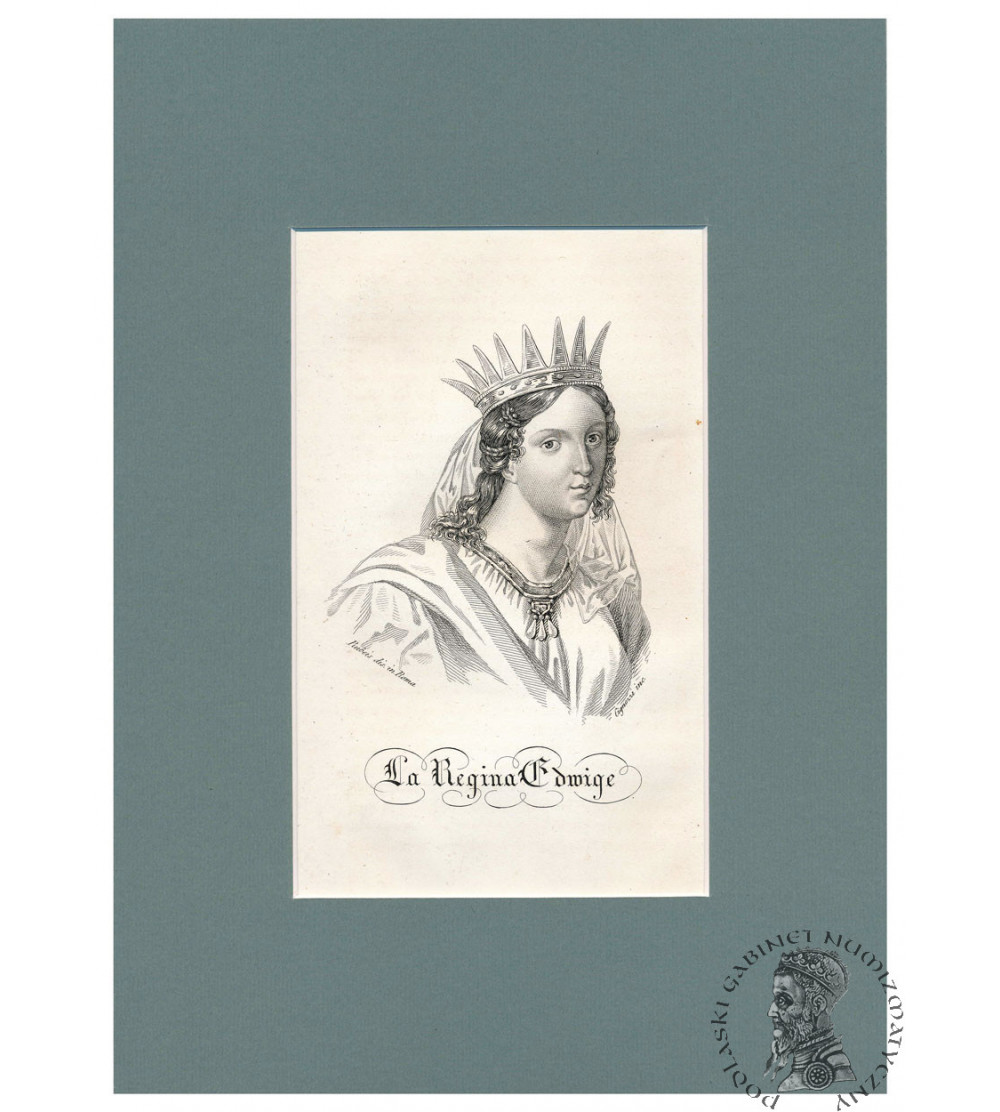




St. Jadwiga Andegawenska / La Regina Edwige, Queen of Poland, portrait, steel engraving 19th century, work from Bernard Zaydler's volume - Storia della Polonia, Florence 1831, all A4 format (passe-partout), image dimensions 11 cm x 18 cm, very good condition.
Jadwiga Andegawenska (1374-1399) Polish monarch of the Andegawen dynasty, the first woman in Polish history to be crowned not queen, but king. She was most likely born in mid-February 1374, although no surviving source from the era records this fact. She was the third daughter and last child of her parents, Hungarian King Louis of Anjou and Queen Elizabeth of Bosnia. Great plans were connected with her birth, expecting the child to turn out to be a boy and thus the heir to the throne saving the dynasty from the specter of extinction. When the girl was born, her father and her influential grandmother, the old Queen Elisabeth Lokietkovna, were forced to take special measures to change the rules of succession - so that the kingdoms held by Louis could pass to his daughters. Before his death, his father saw in Hedwig the future queen of Hungary. Through him, the girl was also betrothed to an Austrian prince, Wilhelm Habsburg. However, when the king passed away, her mother made efforts to deprive the girl of her inheritance, and to pass both thrones - Polish and Hungarian - into the hands of the elder Maria. Her plans were only thwarted by the resistance of the Polish elite, who demanded a separate ruler for themselves, ready to reside in Krakow. After a long and tumultuous interregnum, Jadwiga arrived at the Vistula River in the late summer of 1384 and was crowned king on October 16. In February 1386, she married the newly converted Lithuanian prince Jagiello. She played a progressively more prominent role in politics, including undertaking negotiations with the Grand Master of the Teutonic Order. She was a patroness of science, a great lover of books and a woman of unusual piety. She maintained active contacts with the Holy See and was instrumental in the restoration of the University of Cracow. She died on July 17, 1399 - less than four weeks after giving birth and four days after her only daughter, Elisabeth Boniface, died. source: ciekawostkihistoryczne.pl
,,STORIA DELLA POLONIA" BY BERNARD ZAYDLER - HISTORY OF POLAND IN PICTURES TOLD TO ITALY. The title of the work Storia della Polonia fino agli ultimi tempi scritta dal dottore Bernardo Zaydler Polacco membro della Regia Società degli Amici delle Scienze in Warsavia, e di pare-cchie accademie letterarie italiane can be translated as "History of Poland until the last times written by Dr. Bernard Zaydler, a Pole, member of the Royal Society of Friends of Science in Warsaw and similar literary academies in Italy." It was published in the Florentine outhouse V. Batelli e Figli, in 1831, that is, during the November Uprising, when the Polish-Russian war was taking place on Polish soil. The "ultimi tempi" mentioned in the title, however, did not include the uprising, and the last chapter of the book was devoted to the flourishing Kingdom of Poland under Czar Nicholas I, whose portrait precedes the title page of the publication. The book consists of two volumes, the first of which has 440 pages and the second 720. The work is illustrated with 107 charts, created in intaglio by Florentine printmakers based on contemporary and ancient engravings. There are also two maps depicting the borders of Poland: pre-partition and from 1831. As Jadwiga Jaworska matter-of-factly describes the book's illustrations, they are "flimsy engravings made by mediocre engravers" . Most of their authors are known mainly from this very publication and only their names, often without first names, fixed in signatures under the compositions, have survived to our times. These included: Corsi , Verico , Adamo Bozza , Nasi, Cignozzi. Among the illustrators, the name of Francesco Pieraccini appears , about whom also little is known. Source: Kamilla Pijanowska, National Museum in Warsaw